News
2018
Well, we're into another year and we're already off on a sprint with some great projects. I'm really looking forward to a few more highly efficient homes this year and to continue to build contacts in the field. With a couple in construction at the moment, I hope to post up some pictures soon. There are so many options around for new builds to be energy efficient there is no excuse! Home owners looking for these types of homes are enthusiastic and open to ideas. I am inspired by those that are able to take the step into the future today.
Happy 2018.
- Log in to post comments
Solar Power
We would all love a Spanish holiday right? My family thought so when we had the opportunity to make the most of a trip to Europe. Spain is sunny and warm, the people are friendly and there’s history to boot. But, as an engineer I had some additional plans. Spain is one of the leaders in solar energy technologies with several different style of plant in operation. Before our travel my wife was mildly interested and my two young children had little idea what we would see. When we arrived we were all in awe of this simple and efficient technology.
There are three main types of solar energy collection is use in Spain; PV (Photovoltaic like the panels on your roof), parabolic trough and solar power towers.
Our first visit was the Olmedilla PV park located part way between Valencia and Madrid. This park contains 270,000 panels and is rated at 60MW. It produces 87,500 MWh annually. The park lines the low undulating hills of the area and was surprisingly unobtrusive. It is visible from only a few sections of the main road and is better seen by driving around the small access roads patrolled by a lone security vehicle.
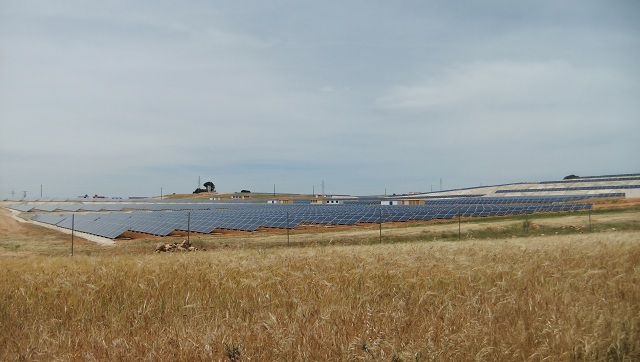
Our second visit near Granada in the South of Spain included both the Andasol parabolic trough and Abengoa solar towers PS10 and PS20. Both of these systems use reflectors to focus the sunlight onto a collector.
In the case of the parabolic trough, this collector is a steel tube filled with a temperature stable synthetic oil. The oil is heated to around 400° C and is pumped through a heat exchanger where it boils water to drive a turbine. The hot oil continues through the system to storage tanks filled with potassium, sodium and nitrate salts. The salts are heated during the day from the excess heat and then transfers the heat back to the oil at night or during rainy periods when it is not being heated by the sun. The Andasol parabolic trough site is made up of three plants, Andasol 1, 2 and 3 and can store enough heat in the salt mix to continue producing full power for 7.5 hours. The three plants combined are rated at 150MW and produces about 180,000 MWh annually.
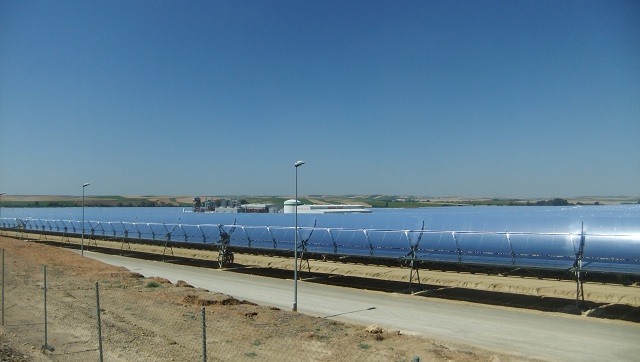
The solar towers PS10 and PS20 use sun tracking reflectors to direct sunlight to a collector at the top of a central 115m high tower. At the collector, water is heated directly to produce steam with one hour of power storage achieved by holding pressurised superheated water in a storage tank. PS10 is rated at 11MW and the improved PS20 rated at 20MW. Together they produce about 71,000MWh annually.
The towers could be seen from some distance away and really looked spectacular with the concentration of sunlight illuminating water vapour and dust in the air to create beams of light.

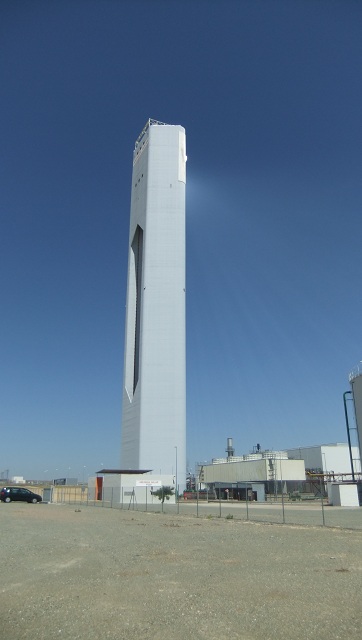
We continued on to visit a third site near Seville called Gemasolar. It is a site adopting a full 360° arc of reflectors focusing the sunlight to a central tower 140m tall. Gemasolar adopts similar molten salt technology to the Andasol parabolic trough plant however it pumps the salt mix directly to the heat exchanger in the tower and then through the storage tanks before being used to produce steam. The plant is rated at 120MW with 15 hours of salt storage and produces 110,000MWh annually.
This site really must be seen to be appreciated. The crisp clean look of the plant and that magnificent collector standing in the middle was well worth the detour to see the site.
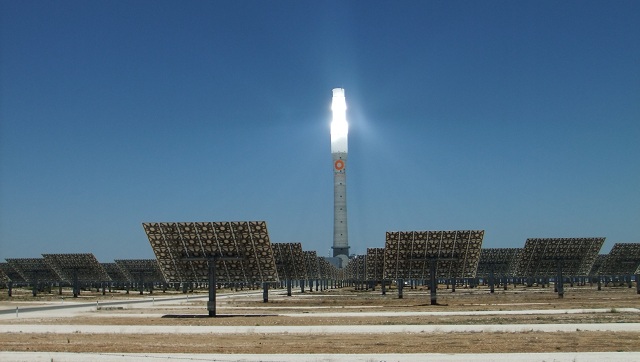
So why don’t we see these plants in Australia? This is a question I have been asked by everyone I have shown our happy snaps to. I think the answer is that we will see them. It is only a matter of time before pressure is put on our aging and polluting coal power stations to invest in new infrastructure and there is no argument that for a new power station, solar thermal plants would be chosen over coal. All you need is a water supply and sun… and we have plenty of sun (just as much as Spain).
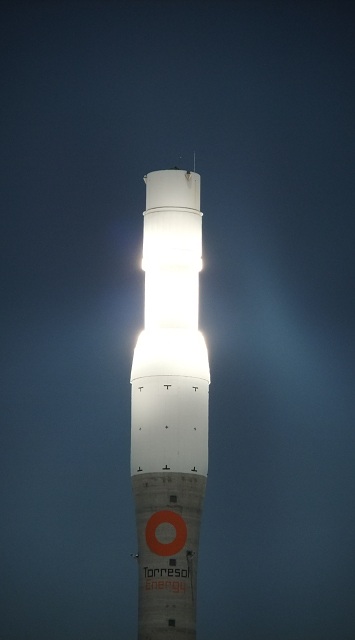
For further information you can visit the operators sites at:
http://www.nobesol.com/?seccion=4&subseccion=2&contenido=40
- Log in to post comments
Engineers Australia Symposium
Having just attended a two day symposium hosted by Engineers Australia here in Melbourne, I am encouraged by the enthusiasm from engineers in regard to sustainability. The event included speakers from various Australian engineering companies and associations, all offering their take on industry practices and visions of the future. Most of the talks were based on studies and experiments and presented in a format for an engineering audience without the sales pitch. It was fantastic to visit the Pixel building in Melbourne and not only hear about successful implementation of green technologies, but also technologies that worked on paper but struggled in practice.
International guest speaker Mike Schlaich from Germany's Technische Universitat Berlin was a highlight for me. He talked about Germany's push toward a solar future with projects like Desertec and the Euro-Supergrid which are fascinating projects that offer real promise for the very near future. All of the technologies to be used exist today with many small scale plants producing power in Spain and the US right now. But what about when the sun doesn’t shine? It seems to be a common misconception that solar can’t provide base load power, however the use of molten salt, water bodies and other heat storage systems can be charged through the day and continue to provide power through the night.
Australia is ideal for these technologies with large uninhabited areas, plenty of sunlight and large potential for power exportation to South East Asia. It is difficult to understand why Australia is not developing these technologies as they offer huge environmental, social and economic advantages in the long term. I guess we are a short term society?
Another surprising highlight was Andreas Kammel from Toyota’s corporate affairs strategy and environment division. His talk was both entertaining and inspirational with many links between the car industry and our engineering profession…. and indeed other professions.
I certainly got a lot from the event and I am sure others did also. I congratulate Engineers Australia for a fantastic and very informative event and hope to attend all those hosted in the future.
- Log in to post comments
Recycling in the building industry
Recently, contractors to my local council were replacing pedestrian paths in the area. I asked them if they could fit some extra concrete into their truck following some home renovations I had been doing. I was confronted with “the tip charges us $x per tonne”. I was astounded that a company collecting concrete as often as this would be paying to take concrete to land fill when there were several local companies that would take the material for free. So an internet search began…
In Australia, 40% of all waste is construction and demolition materials (ABS, 2006). There is no doubt that the cost of sending materials to landfill is not cheap and will continue to increase, so finding viable alternatives makes financial sense as well as reducing wasted material.
There is a significant shift from landfill to recycling across all industries. Many businesses are discovering the value in recycling materials, and recyclers are providing a greater list of materials that can be recycled. It is common to hear people complaining that it is difficult to know what can be recycled and where recyclables can be sent however it is now easier than ever. A simple search can turn up websites such as the Planet Ark site ‘business recycling’, where you can search by material type to be recycled and also look for recyclers in your area: http://businessrecycling.com.au
Materials such as plasterboard, concrete, glass and fibro are easily recycled and it can be free to do so. In fact some wastes will have companies collect the waste and pay you including clean plastic containers and metals. It pays to shop around and when you find a reliable recycler, stick with them.
Recyclers are also offering co-mingled bins, so that all recyclable materials can be placed in the one bin. This particular set up could be appropriate on small job sites or where space is at a premium. http://www.alexfraser.com.au/recycling-bin.html
This Waste Guide provides a practical guide on how to recycle onsite. http://www.business.vic.gov.au/busvicwr/_assets/main/lib60013/wasteguide.pdf
So it’s not hard. A little effort and a phone call or two will have most of your waste materials working as they should.
- Log in to post comments
The site develops
After a little self education I have the site up and running. It has been surprisingly simple to learn the CMS type system with a wealth of learning tools on the web for the non web developer. There isnt a lot of content yet but we'll see it grow. I welcome any suggestions about how an engineering website should look and what content might be useful to visitors.
- Log in to post comments
Welcome to EBD
Welcome to our new website. Its a work in progress, hopefully in full swing this week.
Feel free to contact me using the contact form or the number at the bottom of this page.
